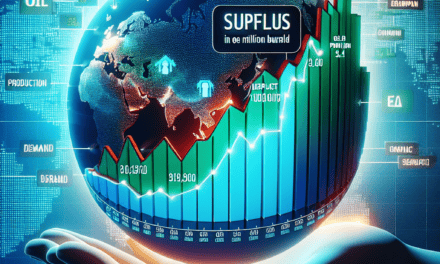“Oil Prices Steady as Dollar Dominance Eases Market Volatility”
Introduction
Oil prices have recently stabilized after experiencing a decline driven by the strengthening of the U.S. dollar. This stabilization comes as global markets adjust to fluctuations in currency values, which have a significant impact on the cost of commodities like oil. The dollar’s appreciation typically makes oil more expensive for holders of other currencies, leading to decreased demand and downward pressure on prices. However, as the market adapts to these currency dynamics, oil prices have found a new equilibrium, reflecting a balance between supply and demand factors and the ongoing influence of macroeconomic conditions. This development is crucial for stakeholders across the energy sector, as it provides a clearer outlook for future pricing and investment decisions.
Impact Of Dollar Strength On Global Oil Markets
The global oil markets have recently experienced a period of stabilization following a notable decline, primarily attributed to the strengthening of the U.S. dollar. This development has significant implications for economies worldwide, as oil prices are intricately linked to the value of the dollar. To understand the impact of dollar strength on global oil markets, it is essential to explore the underlying dynamics and the broader economic context.
The U.S. dollar serves as the primary currency for international oil transactions, making its value a critical factor in determining oil prices. When the dollar appreciates, oil becomes more expensive for countries using other currencies, leading to a decrease in demand. This inverse relationship between the dollar’s strength and oil prices is a fundamental aspect of the global oil market. Recently, the dollar has gained strength due to several factors, including robust economic data from the United States and expectations of tighter monetary policy by the Federal Reserve. As a result, oil prices have faced downward pressure, reflecting the reduced purchasing power of countries with weaker currencies.
Moreover, the interplay between the dollar and oil prices is further complicated by geopolitical factors and supply-demand dynamics. For instance, geopolitical tensions in oil-producing regions can lead to supply disruptions, which may counteract the effects of a strong dollar by driving prices upward. Conversely, an oversupply in the market, often due to increased production by major oil-exporting countries, can exacerbate the downward pressure on prices caused by a strong dollar. Thus, the stabilization of oil prices following their decline is not solely a consequence of currency fluctuations but also a result of these multifaceted interactions.
In addition to these factors, the role of speculative trading in oil markets cannot be overlooked. Traders often respond to currency movements by adjusting their positions in oil futures, which can amplify price volatility. The recent stabilization suggests that traders have adjusted their expectations in light of the dollar’s strength, contributing to a more balanced market. This adjustment process highlights the interconnectedness of financial markets and the importance of investor sentiment in shaping oil prices.
Furthermore, the impact of dollar strength on oil prices has significant implications for both oil-exporting and oil-importing countries. For oil-exporting nations, a strong dollar can lead to reduced revenue from oil sales, as their exports become less competitive. This situation can strain their economies, particularly if they rely heavily on oil exports for income. On the other hand, oil-importing countries may benefit from lower oil prices, which can reduce inflationary pressures and improve trade balances. However, these benefits may be offset by the increased cost of other imports priced in dollars, complicating the overall economic impact.
In conclusion, the stabilization of oil prices following a decline due to dollar strength underscores the complex interplay between currency values, geopolitical factors, and market dynamics. While the dollar’s appreciation has exerted downward pressure on oil prices, other factors such as supply-demand imbalances and speculative trading have also played a role in shaping the current market environment. As global economic conditions continue to evolve, the relationship between the dollar and oil prices will remain a critical area of focus for policymakers, investors, and businesses worldwide. Understanding these dynamics is essential for navigating the challenges and opportunities presented by the ever-changing landscape of global oil markets.
Factors Contributing To The Stabilization Of Oil Prices
The stabilization of oil prices following a period of decline attributed to the strengthening of the U.S. dollar is a multifaceted phenomenon influenced by a variety of factors. Understanding these factors requires a comprehensive analysis of the global economic landscape, market dynamics, and geopolitical influences that collectively shape the oil market. Initially, the appreciation of the U.S. dollar exerted downward pressure on oil prices, as oil is typically priced in dollars. A stronger dollar makes oil more expensive for holders of other currencies, thereby reducing demand. However, the recent stabilization suggests that other forces are at play, counterbalancing the impact of the dollar’s strength.
One significant factor contributing to the stabilization is the strategic production adjustments by major oil-producing countries. The Organization of the Petroleum Exporting Countries (OPEC), along with its allies, often referred to as OPEC+, plays a crucial role in managing oil supply to maintain market balance. In response to the declining prices, OPEC+ has demonstrated a willingness to implement production cuts or maintain existing quotas, thereby reducing supply and supporting prices. This coordinated effort underscores the importance of supply-side management in stabilizing the market.
Moreover, the global economic outlook has shown signs of resilience, which has bolstered demand expectations. Despite concerns over economic slowdowns in certain regions, other areas have experienced robust growth, leading to increased energy consumption. For instance, emerging markets in Asia have continued to expand, driving demand for oil and offsetting weaker demand in other parts of the world. This geographical diversification of demand has provided a stabilizing effect on oil prices, as it mitigates the impact of localized economic fluctuations.
In addition to supply and demand dynamics, geopolitical factors have also played a role in stabilizing oil prices. Tensions in key oil-producing regions can lead to supply disruptions, which in turn can support prices. For example, conflicts or political instability in the Middle East, a region that holds a significant portion of the world’s oil reserves, can create uncertainty in the market. This uncertainty often results in a risk premium being factored into oil prices, thereby contributing to their stabilization.
Furthermore, technological advancements and strategic reserves have provided additional layers of stability. The development of more efficient extraction and production technologies has enabled producers to respond more swiftly to market changes, ensuring a more balanced supply. Additionally, the existence of strategic petroleum reserves in various countries acts as a buffer against sudden supply shocks, providing reassurance to the market and preventing extreme price volatility.
Lastly, investor sentiment and market speculation also influence oil price stabilization. Financial markets play a crucial role in setting oil prices, as traders and investors react to news and forecasts. A shift in sentiment, driven by positive economic indicators or successful diplomatic negotiations, can lead to increased confidence in the market, thereby stabilizing prices. Speculative activities, while sometimes contributing to volatility, can also lead to price corrections that align with fundamental market conditions.
In conclusion, the stabilization of oil prices following a decline due to dollar strength is the result of a complex interplay of factors. Strategic production adjustments by OPEC+, resilient global demand, geopolitical influences, technological advancements, and market sentiment all contribute to this stabilization. Understanding these elements provides valuable insights into the mechanisms that underpin the oil market, highlighting the intricate balance between supply, demand, and external influences that ultimately determine price stability.
The Role Of Currency Fluctuations In Commodity Pricing
The intricate relationship between currency fluctuations and commodity pricing is a subject of considerable interest to economists and market analysts alike. Recently, oil prices have stabilized following a period of decline, primarily attributed to the strengthening of the U.S. dollar. This development underscores the significant impact that currency valuations can have on global commodity markets. To understand this dynamic, it is essential to explore how currency fluctuations influence commodity prices, particularly in the context of oil, a critical global resource.
Oil, like many other commodities, is predominantly traded in U.S. dollars. Consequently, the value of the dollar plays a pivotal role in determining oil prices on the international market. When the dollar strengthens, it effectively increases the cost of oil for countries using other currencies. This is because they need more of their local currency to purchase the same amount of oil, leading to a decrease in demand. Conversely, when the dollar weakens, oil becomes cheaper for these countries, potentially boosting demand and driving prices up. Thus, the recent stabilization of oil prices can be attributed to the interplay between the dollar’s strength and global demand dynamics.
Moreover, the relationship between currency fluctuations and commodity pricing is not unidirectional. While a strong dollar can suppress oil prices by reducing demand, it can also lead to increased production costs for oil-exporting countries. These nations often face higher expenses for goods and services priced in dollars, which can squeeze profit margins and potentially lead to reduced output. This reduction in supply can counterbalance the initial price decline, contributing to the stabilization observed in the market.
In addition to these direct effects, currency fluctuations can also influence oil prices through their impact on investor behavior. A strong dollar often signals a robust U.S. economy, which can attract investment away from commodities and into dollar-denominated assets such as stocks and bonds. This shift in investment can lead to a decrease in speculative demand for oil, further exerting downward pressure on prices. However, as investors adjust their portfolios in response to changing economic conditions, this can also lead to periods of price stabilization as market participants reassess their strategies.
Furthermore, it is important to consider the broader economic context in which these currency fluctuations occur. Geopolitical events, monetary policy decisions, and economic indicators all play a role in shaping currency values and, by extension, commodity prices. For instance, recent interest rate hikes by the Federal Reserve have contributed to the dollar’s strength, as higher rates tend to attract foreign capital seeking better returns. This monetary policy stance, aimed at curbing inflation, has had a ripple effect on global markets, influencing both currency valuations and commodity prices.
In conclusion, the stabilization of oil prices following a decline due to dollar strength highlights the complex interplay between currency fluctuations and commodity pricing. As the global economy continues to evolve, understanding these dynamics becomes increasingly important for policymakers, investors, and businesses alike. By recognizing the multifaceted nature of these relationships, stakeholders can better navigate the challenges and opportunities presented by the ever-changing landscape of international markets. As such, the role of currency fluctuations in commodity pricing remains a critical area of study, offering valuable insights into the mechanisms that drive global economic activity.
Economic Implications Of Stabilized Oil Prices

The recent stabilization of oil prices, following a period of decline attributed to the strengthening of the U.S. dollar, has significant economic implications that warrant careful consideration. As oil prices stabilize, various sectors of the global economy are poised to experience both direct and indirect effects. Understanding these implications requires an examination of the interconnectedness of currency fluctuations, energy markets, and broader economic trends.
Initially, the decline in oil prices was largely driven by the appreciation of the U.S. dollar. A stronger dollar makes oil, which is priced in dollars, more expensive for holders of other currencies, thereby reducing demand and exerting downward pressure on prices. However, as oil prices stabilize, it suggests a recalibration of market forces, where supply and demand dynamics are finding a new equilibrium. This stabilization can be attributed to several factors, including adjustments in production levels by major oil-producing countries and shifts in global energy consumption patterns.
The stabilization of oil prices has profound implications for both oil-exporting and oil-importing nations. For oil-exporting countries, stabilized prices can provide a more predictable revenue stream, which is crucial for economic planning and fiscal stability. These nations often rely heavily on oil revenues to fund public services and infrastructure projects. Consequently, stabilized prices can help mitigate the economic volatility that accompanies sharp price fluctuations, allowing for more consistent economic growth and development.
Conversely, for oil-importing countries, stabilized oil prices can alleviate some of the inflationary pressures that arise from volatile energy costs. When oil prices are unpredictable, it can lead to increased costs for transportation and manufacturing, which are often passed on to consumers in the form of higher prices for goods and services. Stabilized prices can help moderate these costs, contributing to more stable inflation rates and potentially enhancing consumer confidence and spending.
Moreover, the stabilization of oil prices has implications for the global energy transition. As the world increasingly shifts towards renewable energy sources, stable oil prices can influence investment decisions in the energy sector. On one hand, stable prices may reduce the urgency for rapid investment in alternative energy sources, as the immediate economic pressures of high oil prices are alleviated. On the other hand, predictable oil prices can provide a more stable environment for long-term planning and investment in sustainable energy infrastructure, as stakeholders can better anticipate future market conditions.
In addition to these sector-specific impacts, stabilized oil prices can also affect global trade balances and currency markets. For countries with significant oil imports or exports, changes in oil prices can influence trade deficits or surpluses, which in turn can impact currency valuations. A stable oil price environment can contribute to more balanced trade relationships and reduce the likelihood of abrupt currency fluctuations, fostering a more stable global economic environment.
In conclusion, the stabilization of oil prices following a decline due to dollar strength carries multifaceted economic implications. By providing a more predictable framework for both oil-exporting and oil-importing countries, stabilized prices can enhance economic planning, moderate inflationary pressures, and influence the trajectory of the global energy transition. As such, stakeholders across various sectors must remain vigilant in monitoring these developments to navigate the evolving economic landscape effectively.
How Oil Producers Are Adapting To Currency-Driven Price Changes
In recent months, the global oil market has witnessed a stabilization in prices following a period of decline largely attributed to the strengthening of the U.S. dollar. This currency-driven fluctuation has prompted oil producers worldwide to adapt their strategies in order to mitigate the impact on their revenues. As the dollar appreciates, oil prices, which are typically denominated in dollars, tend to decrease, making it crucial for producers to navigate these changes effectively.
One of the primary strategies employed by oil producers is the diversification of their currency exposure. By engaging in financial instruments such as currency hedging, producers can protect themselves against adverse currency movements. Hedging allows them to lock in exchange rates for future transactions, thereby reducing the uncertainty associated with fluctuating currency values. This approach not only stabilizes their income but also provides a more predictable financial environment in which to operate.
In addition to financial strategies, oil producers are increasingly focusing on cost optimization to maintain profitability. This involves streamlining operations, investing in technology, and enhancing efficiency across the supply chain. By reducing production costs, companies can better withstand periods of lower oil prices. For instance, advancements in drilling technology and automation have enabled producers to extract oil more efficiently, thereby lowering the breakeven price per barrel. This technological evolution is crucial in ensuring that producers remain competitive even when market conditions are less favorable.
Moreover, oil producers are exploring new markets and diversifying their customer base to reduce dependency on traditional buyers. By expanding into emerging markets, they can tap into new sources of demand, which can help offset the impact of currency fluctuations. This strategic shift not only broadens their market reach but also enhances their resilience against regional economic downturns. Furthermore, establishing long-term contracts with buyers in different currencies can provide a buffer against dollar strength, as it allows producers to receive payments in more stable or appreciating currencies.
Another significant adaptation involves the strategic management of production levels. By carefully adjusting output in response to market signals, producers can influence supply and demand dynamics, thereby exerting some control over price levels. This approach requires a delicate balance, as overproduction can exacerbate price declines, while underproduction may lead to missed revenue opportunities. Consequently, producers are increasingly relying on data analytics and market intelligence to make informed decisions about production adjustments.
Collaboration among oil-producing nations also plays a vital role in stabilizing the market. Through organizations such as OPEC and its allies, producers can coordinate production cuts or increases to manage global supply effectively. These collaborative efforts are instrumental in maintaining price stability, especially during periods of significant currency-driven volatility. By working together, producers can collectively navigate the challenges posed by a strong dollar, ensuring that the market remains balanced and sustainable.
In conclusion, the stabilization of oil prices following a decline due to dollar strength has prompted oil producers to adopt a multifaceted approach to adapt to currency-driven changes. Through financial strategies, cost optimization, market diversification, production management, and international collaboration, producers are better equipped to navigate the complexities of the global oil market. As they continue to refine these strategies, they enhance their ability to maintain profitability and resilience in the face of ongoing currency fluctuations.
Future Projections For Oil Prices Amid Currency Volatility
In recent months, the global oil market has experienced a period of stabilization following a notable decline in prices, primarily attributed to the strengthening of the U.S. dollar. This development has prompted analysts and industry stakeholders to closely examine future projections for oil prices amid ongoing currency volatility. As the dollar appreciates, it exerts downward pressure on oil prices, given that oil is predominantly traded in dollars. Consequently, a stronger dollar makes oil more expensive for holders of other currencies, leading to reduced demand and, subsequently, lower prices. This dynamic has been a significant factor in the recent stabilization of oil prices.
Looking ahead, several factors are poised to influence the trajectory of oil prices. One of the primary considerations is the interplay between global economic growth and energy demand. As economies recover from the disruptions caused by the COVID-19 pandemic, energy consumption is expected to rise, potentially driving up oil prices. However, this anticipated increase in demand may be tempered by the ongoing transition towards renewable energy sources and the implementation of more stringent environmental regulations. These factors could mitigate the upward pressure on oil prices, leading to a more balanced market.
Moreover, geopolitical developments continue to play a crucial role in shaping oil price dynamics. Tensions in key oil-producing regions, such as the Middle East, can lead to supply disruptions, thereby exerting upward pressure on prices. Conversely, diplomatic efforts to resolve conflicts and stabilize production can contribute to price stability. Additionally, the policies of major oil-producing nations, particularly those within the Organization of the Petroleum Exporting Countries (OPEC), are instrumental in determining supply levels and, consequently, price trends. OPEC’s production decisions, often influenced by both economic and political considerations, will remain a critical factor in the future of oil prices.
Another important aspect to consider is the impact of technological advancements on oil production and consumption. Innovations in extraction techniques, such as hydraulic fracturing and horizontal drilling, have significantly increased the supply of oil, particularly in the United States. This surge in production capacity has contributed to a more competitive market, potentially capping price increases. On the consumption side, advancements in energy efficiency and the growing adoption of electric vehicles are expected to reduce oil demand over the long term. These technological trends are likely to influence the balance between supply and demand, thereby affecting future oil prices.
Furthermore, the role of financial markets in shaping oil price expectations cannot be overlooked. Speculative trading and investment strategies can lead to price fluctuations, as market participants react to economic indicators, geopolitical events, and policy announcements. The interplay between physical supply and demand factors and financial market dynamics adds a layer of complexity to projecting future oil prices.
In conclusion, while the recent stabilization of oil prices following a decline due to dollar strength provides a temporary respite, the future trajectory of oil prices remains subject to a multitude of influencing factors. Economic growth, geopolitical developments, technological advancements, and financial market dynamics will all play pivotal roles in shaping the outlook for oil prices amid currency volatility. As these elements continue to evolve, stakeholders in the oil market will need to remain vigilant and adaptable to navigate the complexities of this ever-changing landscape.
The Interplay Between Oil Prices And Global Economic Health
The recent stabilization of oil prices, following a period of decline attributed to the strengthening of the U.S. dollar, underscores the intricate relationship between oil markets and global economic health. This dynamic interplay is a critical factor in understanding the broader economic landscape, as fluctuations in oil prices can have far-reaching implications for both producing and consuming nations. The stabilization comes after a period of volatility, during which the dollar’s appreciation exerted downward pressure on oil prices. A stronger dollar makes oil, priced in dollars, more expensive for holders of other currencies, thereby reducing demand and contributing to price declines. However, the recent stabilization suggests a recalibration in the market, as other factors begin to exert influence.
One such factor is the balance of supply and demand. While the dollar’s strength played a significant role in the initial decline, the stabilization indicates that supply-side considerations are also at play. OPEC and its allies, collectively known as OPEC+, have been closely monitoring production levels to prevent oversupply, which could further depress prices. Their strategic output adjustments have been instrumental in maintaining a semblance of balance in the market. Moreover, geopolitical tensions in key oil-producing regions can also impact supply dynamics, adding another layer of complexity to the pricing equation.
On the demand side, global economic health remains a pivotal determinant of oil consumption patterns. Economic growth in major economies, such as China and India, can drive increased demand for oil, thereby supporting prices. Conversely, economic slowdowns or recessions can lead to reduced energy consumption, exerting downward pressure on prices. The recent stabilization may reflect a cautious optimism about the global economic outlook, as countries continue to navigate the challenges posed by inflationary pressures and geopolitical uncertainties.
Furthermore, the role of alternative energy sources cannot be overlooked in this context. As the world increasingly shifts towards renewable energy, the long-term demand for oil may face structural changes. However, in the short to medium term, oil remains a critical component of the global energy mix, and its pricing will continue to be influenced by traditional market forces. The interplay between oil prices and global economic health is further complicated by the actions of financial markets. Speculative trading and investment flows can amplify price movements, sometimes leading to disconnects between market prices and underlying supply-demand fundamentals. The recent stabilization may suggest a return to more fundamentals-driven pricing, as market participants reassess their positions in light of evolving economic indicators.
In conclusion, the stabilization of oil prices following a decline due to dollar strength highlights the multifaceted nature of the oil market. While currency fluctuations are a significant factor, they are but one piece of a larger puzzle that includes supply-demand dynamics, geopolitical developments, economic growth prospects, and the transition to alternative energy sources. Understanding this complex interplay is essential for policymakers, businesses, and investors alike, as they navigate the challenges and opportunities presented by the global energy landscape. As the world continues to evolve, the relationship between oil prices and global economic health will remain a key area of focus, with implications that extend far beyond the confines of the energy sector.
Q&A
1. **Question:** What caused the recent decline in oil prices?
**Answer:** The recent decline in oil prices was caused by the strengthening of the U.S. dollar.
2. **Question:** How does a stronger dollar impact oil prices?
**Answer:** A stronger dollar makes oil more expensive for holders of other currencies, which can lead to decreased demand and lower prices.
3. **Question:** What factors contributed to the stabilization of oil prices after the decline?
**Answer:** Factors such as adjustments in supply, geopolitical developments, and market expectations about future demand contributed to the stabilization of oil prices.
4. **Question:** How do geopolitical developments influence oil prices?
**Answer:** Geopolitical developments can affect oil supply and demand dynamics, leading to changes in prices due to potential disruptions or changes in production levels.
5. **Question:** What role do market expectations play in oil price stabilization?
**Answer:** Market expectations about future supply and demand, economic conditions, and policy changes can influence investor behavior and contribute to price stabilization.
6. **Question:** How might changes in oil supply affect prices?
**Answer:** Changes in oil supply, such as increased production or cuts by major producers, can lead to shifts in prices depending on whether supply exceeds or falls short of demand.
7. **Question:** What are potential future trends for oil prices given the current economic conditions?
**Answer:** Potential future trends for oil prices may include continued volatility due to economic uncertainties, changes in energy policies, and shifts in global demand patterns.
Conclusion
Oil prices have stabilized after experiencing a decline attributed to the strengthening of the U.S. dollar. This stabilization suggests that the market has adjusted to the currency fluctuations, with supply and demand dynamics finding a new equilibrium. The initial drop in oil prices was largely driven by the dollar’s appreciation, which made oil more expensive for holders of other currencies, thereby reducing demand. However, as the market absorbed these changes, prices leveled off, indicating that other factors, such as production levels and geopolitical influences, are now playing a more significant role in maintaining price stability. This stabilization may provide a more predictable environment for both producers and consumers, although ongoing monitoring of currency movements and economic indicators remains essential for anticipating future price trends.





